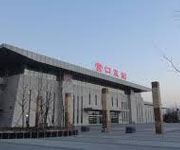
The city is home to the basketball club Liaoning Flying Leopards of the Chinese Basketball Association. The club brought forth several players of China's national basketball team. It plays its home games at the Benxi Gymnasium.
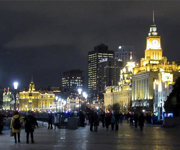
Located in the Yangtze River Delta in East China, Shanghai sites at the mouth of the Yangtze in the middle portion of the Chinese coast, the climate in this city is humid and good for people’s heath. Its traffic is very convenient for people’s life. For centuries a major administrative, education, shipping and trading town, Shanghai played an important role in the development of China’s economy. As a metropolis in the world, with its unique styles and features Shanghai attracted more and more foreign people, especially foreign students.Shanghai became a second largest city for students to study after Beijing.

Xiamen (Mandarin pronunciation: [ɕjâmə̌n]), also historically known as Amoy /əˈmɔɪ/, POJ Hokkien: ε̄-mûiⁿ; Ē-mn̂g, is a major city on the southeast (Taiwan Strait) coast of the People's Republic of China. It is administered as a sub-provincial city of Fujian province, with an area of 1,699.39 square kilometres (656.14 sq mi) and population of 3,531,347 at the 2010 Census. The city's urban area includes the old urban island area and covers all six districts of Xiamen (Huli, Siming, Jimei, Tong'an, Haicang and recently Xiang'an), and has a total urban population of 1,861,289. It also borders Quanzhou to the north and Zhangzhou making this a unique built up area of more than five million people. The Jinmen (Kinmen) Islands administered by the Republic of China (Taiwan) are less than 10 kilometres (6.2 mi) away.

As the capital of Guangdong province in South China, Guangzhou, serves as an important national transportation hub and trading port. Located just south of the Tropic of Cancer,Guangzhou has a humid subtropical climate influenced by the East Asian monsoon.Summers are wet with high temperatures, high humidity and a high heat index. Winters are mild and comparatively dry. Guangzhou is one of mainland China’s Leading commercial and manufacturing regions, its education level is very high, many international students apply for university which located in Guangzhou.
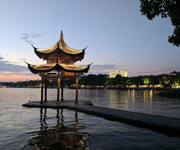
Hangzhou, as the capital of Zhejiang Province in Eastern China, Hangzhou's climate is humid subtropical with four distinctive seasons, characteristiced by long, very hot, humid summers and chilly, cloudy and drier winters (with occasional snow). Its traffic is convenient for people’s life. For foreign students, hangzhou is served by the Hangzhou Xiaoshan International Airport, which provides direct service to many international destinations such as Thailand, Japan, South Korea, Malaysia, India, Vietnam, Ethiopia, Singapore, and the Netherlands Hangzhou has a large student population with many higher education institutions based in the city. Public universities include Zhejiang University, Zhejiang University of Technology, and Hangzhou Normal University etc. Owing to different needs,more and more students come to study in this city .
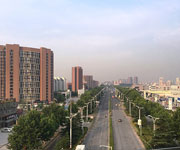
Nanjing is the capital of Jiangsu province in Eastern China. Located in the lower Yangtze River drainage basin and Yangtze River Delta economic zone, it was a prominent place in Chinese history and culture, having been the capital of China for several periods and was recognized as one of the Four Great Ancient Capitals of China. Now, Nanjing has been ranked seventh in the evaluation of “Cities with strongest Comprehensive Strength” issued by the National statistics Bureau. Nanjing has been the educational center in southern China for more than 1700 years. Currently, it boasts of some of the most prominent educational institutions in the region like China Pharmaceutical University, Nanjing University, etc. With its special characteristics, many international students choose to study in Nanjing.

Chengdu, formerly romanized as Chengtu, is the provincial capital of Sichuan province in Southwest China, as well as a major city in Western China. It holds sub-provincial administrative status. The administrative area houses 14,047,625 inhabitants: 7,415,590 within the municipality's nine urban districts and 6,632,035 in the surrounding satellite towns and counties' urban, suburb and rural area. According to the 2010 census, Chengdu is the fourth most populous city in China. Chengdu is one of the most important economic, finance, commerce, culture, transportation, and communication centers in Western China. Chengdu Shuangliu International Airport is one of the top 50 busiest airports in the world, and Chengdu Railway Station is one of the six biggest train stations in China. According to the 2007 Public Appraisal for Best Chinese Cities for Investment, Chengdu was chosen as one of the top ten cities to invest in out of a total of 280 urban centers in China. Chengdu is also popular in international company and consulates.More than 250 Fortune 500 companies and 10 consulates have established branches in Chengdu due to huge demand of Western China. In 2006, it was named China's 4th-most livable city by China Daily.
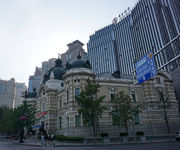
Dalian is a major city and seaport in the south of Liaoning Province, People's Republic of China. It is the southernmost city of Northeast China and China's northernmost warm water port, at the tip of the Liaodong Peninsula. Dalian is the province's second largest city and has sub-provincial administrative status; only the provincial capital (Shenyang) is larger. The Shandong Peninsula lies southwest across the Bohai Sea; Korea lies across the Yellow Sea to the east. Today, a financial, shipping and logistics center for Northeast Asia, Dalian has a significant history of being used by foreign powers for its ports: Dalian proper was previously known as both Dalny (Russian: Дальний; Dal'nii) and Dairen (Japanese: 大連) but it was better known as both Port Arthur (Russian: Порт-Артур; Port-Artur) and Ryojun (Japanese: 旅順) from its Lüshunkou district. In 2006, Dalian was named China's most livable city by China Daily.
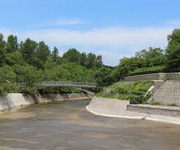
Changchun is the capital and largest city of Jilin province, located in the northeast of the People's Republic of China, in the center of the Songliao Plain. It is administered as a sub-provincial city including counties and county-level cities, with a population of 7,674,439 at the 2010 census under its jurisdiction. The city's built-up (or metro) area, including 5 districts and 4 development areas, had a population of 3,815,270 in 2010 as Shuangyang district is not conurbated yet. The name, which means "Long Spring", originated from the Jurchen language. Known as China's Automobile City, Changchun is an important industrial base with a particular focus on the automotive sector. Apart from this industrial aspect, Changchun is also one of four "National Garden Cities" awarded by the Ministry of Construction of P.R. China in 2001 due to its high urban greening rate.

Changsha (simplified Chinese: 长沙; traditional Chinese: 長沙; pinyin: Chángshā) is the capital of Hunan Province in south-central China, located on the lower reaches of the Xiang River, a branch of the Yangtze River. Its municipality covers an area of 11,819 square kilometres (4,563 sq mi) and, according to the 2010 Census, a population of 7,044,118 inhabitants. The city's urban area has a population of 3,617,469. Changsha was important from the time of the Qin dynasty (221–207 BC). In AD 750–1100 Changsha was a major commercial hub, and its population increased greatly. Under the Qing dynasty, from 1664, it was the capital of Hunan province, and it was a major rice market. It was besieged during the Taiping Rebellion but never fell. Changsha was the site of Mao Zedong's conversion to communism. It was the scene of major battles in the Sino-Japanese War of 1937–45 and was briefly occupied by the Japanese. Rebuilt since 1949, the city is now a major interior port and a commercial and industrial center.

Zhenjiang (Chinese Postal Map Romanisation: Chenkiang; simplified Chinese: 镇江; traditional Chinese: 鎮江; pinyin: Zhènjiāng) is a city in Jiangsu province, in eastern China. Sitting on the southern bank of the Yangtze River, Zhenjiang is governed as a Prefecture-level city; it borders the provincial capital of Nanjing to the west, Changzhou to the east, and Yangzhou across the river to the north. Once known as Jingjiang (Chinese: 京江; Chinese Postal Map Romanisation: Kingkiang) or Jingkou (Chinese: 京口; Chinese Postal Map Romanisation: Kingkow), Zhenjiang is today an important transportation hub, owing to its location near the intersection of the Yangtze River and the Grand Canal.

Jinan (Chinese: 济南市) is the capital of Shandong province in Eastern China. The area of present-day Jinan has played an important role in the history of the region from the earliest beginnings of civilization and has evolved into a major national administrative, economic, and transportation hub. The city has held sub-provincial administrative status since 1994. Jinan is often referred to as the 'Spring City' for its well-known 72 artesian springs inside urban area. Its population was 6,813,984 at the 2010 census whom 4,335,989 lived in the built-up (or metro) area made up of 6 urban districts.

Zhengzhou is the capital of Henan Province located in east-central China. As a prefecture-level city, it also serves as the political, economic, technological, and educational centre of the province, as well as a major transportation hub for Central China. The city lies on the southern bank of the Yellow River, and is one of the Eight Great Ancient Capitals of China. With 8,626,505 inhabitants according to the 2010 census and 4,867,388 in its built-up area (6 urban districts + Xingyang City), the city is one of the main built up areas of Henan region. Zhengzhou is now a rapidly growing city. Greater Zhengzhou was named as one of the 13 emerging megacities or megalopolises in China in a July 2012 report by the Economist Intelligence Unit.
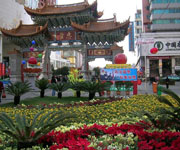
Kunming is the capital and largest city in Yunnan Province, Southwest China. Known as Yunnan-Fu (云南府, Yúnnánfǔ) until the 1920s, today it is a prefecture-level city and the political, economic, communications and cultural centre of the province as well as the seat of the provincial government. The city is also home to several universities, museums, galleries and other important economic, cultural, and educational institutions. The headquarters of many of Yunnan's large businesses are in Kunming as well. It was important during World War II as a Chinese military center, American air base, and transport terminus for the Burma Road. Located in the middle of the Yunnan–Guizhou Plateau, Kunming is located at an altitude of 1,900 metres (6,234 feet) above sea level and at a latitude just north of the Tropic of Cancer. It covers an area of 21,473 square kilometres (8,291 sq mi) and its urban area covers 2,622 square kilometres (1,012 sq mi). Kunming has population of 6,432,212, including 3,583,429 in the built-up area made up of 4 urban and 1 suburban districts, and is located at the northern edge of the large Lake Dian, surrounded by temples and lake-and-limestone hill landscapes.
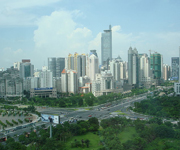
Nanning (simplified Chinese: 南宁; traditional Chinese: 南寧; Zhuang: Namzningz; meaning 'South Tranquility') is the capital of the Guangxi Zhuang Autonomous Region in southern China. It is known as the "Green City" because of its abundance of lush tropical foliage.
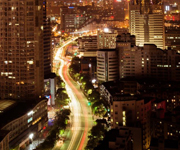
Ningbo (help·info) (Chinese: 宁波; pinyin: Níngbō; Ningbo dialect: About this sound Nyin-poh/Nyin-pou (help·info)), also formerly written Ningpo, is a seaport city in the northeast of Zhejiang province, People's Republic of China. Holding sub-provincial administrative status and separate state-planning status, as of the 2010 census, the municipality had a population of 7.6 million — with 3.5 residing in the built-up (or metro) area made of the 6-district urban area proper. Ningbo lies south of the Hangzhou Bay, which separates it from the municipalities of Jiaxing and Shanghai; to the east it faces the East China Sea; borders Shaoxing to the west; borders Taizhou to the south; and is separated from Zhoushan by a narrow body of water.
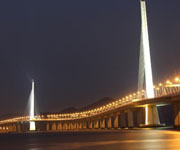
Shenzhen (Chinese: 深圳) is a major city in the south of Southern China’s Guangdong Province, situated immediately north of Hong Kong Special Administrative Region. The area became China’s first—and one of the most successful—Special Economic Zones (SEZs). It currently also holds sub-provincial administrative status, with powers slightly less than a province. According to a report published by Shenzhen Daily in 2012, Shenzhen has a population of approximately 15 million. It's one of the most built-up areas in the world and the so-called Pearl River Delta Mega City had more than 44.7 million inhabitants at the 2010 census spread over 9 municipalities (including Macao) and an area of 17,573 km2. Shenzhen’s modern cityscape is the result of the vibrant economy made possible by rapid foreign investment since the institution of the policy of “reform and opening” establishment of the SEZ in late 1979, before which it was only a small village. Both Chinese citizens and foreign nationals have invested enormous amounts of money in the Shenzhen SEZ. More than US$30 billion in foreign investment has gone into both foreign-owned and joint ventures, at first mainly in manufacturing but more recently in the service industries as well. Shenzhen is now considered one of the fastest-growing cities in the world.

Shenyang, formerly romanized as Mukden, is the capital and largest city of Liaoning Province, as well as the largest city in Northeast China by urban population. According to the 2010 census, the city's urban area has 6,255,921 inhabitants, while the total population of the Shenyang municipality is up to 8,106,171. Currently holding sub-provincial administrative status, the city was once known as Shengjing or Fengtian Prefecture. In the 17th century, Shenyang was conquered by the Manchu people and briefly used as the capital of the Qing dynasty. Along with its nearby cities, Shenyang is an important industrial centre in China, and serves as the transportation and commercial hub of China's northeast—particularly with Japan, Russia, and Korea.[9] A titan of heavy industry since the 1930s, and the spearhead of the Chinese central government's Northeast Area Revitalization Plan, the city has been diversifying its industry and now has a solid industrial foundation, a good land and air transport network, abundant natural resources, and a skilled workforce.

Suzhou, formerly romanized as Soochow, is a major city in the southeast of Jiangsu Province in Eastern China, adjacent to Shanghai Municipality. It is a major economic centre and focal point of trade and commerce, and the second largest city in the province after its capital Nanjing. The city is situated on the lower reaches of the Yangtze River and the shores of Lake Tai and belongs to the Yangtze River Delta region. Administratively, Suzhou is a prefecture-level city with a population of 4.33 million in its city proper, and a total resident population (as of 2013) of 10.58 million in its administrative area, which incorporates neighboring suburban regions and the satellite cities of Kunshan, Lianyungang, Taicang, and Changshu. Its urban population grew at an unprecedented rate of 6.5% between 2000 and 2014, which is the highest among cities with more than 5 million people. Founded in 514 BC, Suzhou has over 2,500 years of history, with an abundant display of relics and sites of historical interest. At around 100 AD, during the Eastern Han Dynasty, it became one of the ten largest cities in the world mostly due to emigration from North China. Since the 10th-century Song Dynasty, it has been an important commercial center of China. During the Ming and Qing Dynasty, Suzhou was a national economic, cultural and commercial center, as well as the largest non-capital city in the world, until the 1860 Taiping Rebellion. When Li Hongzhang and Charles George Gordon recaptured the city three years later, Shanghai had already taken its predominant place in the nation. Since major economic reforms began in 1978, Suzhou has become one of the fastest growing major cities in the world, with GDP growth rates of about 14% in past 35 years. With high per capita incomes, Suzhou's Human Development Index ratings is roughly comparable to a moderately developed country, making it one of the most highly developed and propserous cities on the Chinese mainland.


Weifang (simplified Chinese: 潍坊; traditional Chinese: 濰坊; pinyin: Wéifāng) is a prefecture-level city in central Shandong province, People's Republic of China. It borders Dongying to the northwest, Zibo to the west, Linyi to the southwest, Rizhao to the south, Qingdao to the east, and looks out to the Laizhou Bay to the north. Its population was 9,086,241 at the 2010 census whom 2,659,938 in the built-up (or metro) area made up of 4 urban districts (Kuiwen, Weicheng, Hanting and Fangzi) and Changle County largely being urbanized.

Wuhan, is the capital of Hubei province. It lies in the eastern Jianghan Plain at the intersection of the middle reaches of the Yangtze and Han rivers. It is a major transportation hub with dozens of railways,roads and expressways passing through the city. For its crucial location in domestic transportation, Wuhan was to some degree referred to as the Chicago of China.” Wuhan Tianhe International Airport is one of the busiest airports in central China and it is located 26 kilometres (16 mi) north of Wuhan. The education level of this city is comparatively high than normal city. Many famous university of this city attracted more and more international students.

Harbin (help·info) is the capital and largest city of Heilongjiang province, People's Republic of China. Holding sub-provincial administrative status, Harbin has direct jurisdiction over 9 metropolitan districts, 2 county-level cities and 7 counties. Harbin is the eighth most populous Chinese city and the most populous city in Northeast China. According to the 2010 census, the built-up area made of 7 out of 9 urban districts (all but Shuangcheng and Acheng not urbanized yet) had 5,282,093 inhabitants, while the total population of the sub-provincial city was up to 10,635,971. Harbin serves as a key political, economic, scientific, cultural and communications hub in Northeast China, as well as an important industrial base of the nation.

Zhoushan (help·info); formerly transliterated as Chusan, is a prefecture-level city in northeastern Zhejiang province of Eastern China. One of the two prefecture-level cities of the People's Republic of China consisting solely of islands (the other is Sansha in Hainan, however its territory is in dispute), it lies across the mouth of the Hangzhou Bay, and is separated from the mainland by a narrow body of water. On 8 July 2011 the central government approved Zhoushan's as Zhoushan Archipelago New Area a state-level new area. At the 2010 census, its population was 1,121,261 whom 842,989 lived in the built-up area made of Dinghai and Putuo counties.

Jiaozuo (Chinese: 焦作; pinyin: Jiāozuò; Postal map spelling: Tsiaotso) is a prefecture-level city in northern Henan province, People's Republic of China. Sitting on the northern bank of the Yellow River, it borders the provincial capital of Zhengzhou to the south, Xinxiang to the east, Jiyuan to the west, Luoyang to the southwest, and the province of Shanxi to the north. Its population was 3,540,101 at the 2010 census whom 1,301,732 live in the built-up area made of 4 urban districts (Jiefang, Shanyang, Zhongzhan and Macun) and Bo'ai County being urbanized. Jiaozuo enjoys a humid subtropical climate with continental climate influences,winters are cool and relatively dry while summers are hot and often rainy.average temperature ranges from 0.3 °C in January to 27.5 °C in July.Extremes exist from -22.4 °C to 43.6 °C °C,precipitation averages 659mm.

Qinhuangdao is a port city and prefecture-level city in northeastern Hebei province, People's Republic of China. It is about 300 km (190 mi) east of Beijing, on the Bohai Sea, the innermost gulf of the Yellow Sea. Its population during the 2010 census was 2,987,605, with 1,029,670 living in the built-up (or metro) area made of 3 urban districts.

Tangshan (Chinese: 唐山; pinyin: Tángshān) is a largely industrial prefecture-level city in northeastern Hebei province, People's Republic of China. It has become known for the 1976 Tangshan earthquake which measured 7.8 on the Richter scale and killed at least 255,000 residents. The city has since been rebuilt and has become a tourist attraction. The city of Tangshan is approximately 149 kilometers, 92 miles or 80 nautical miles east by south east of the country's capital city of Beijing. It takes roughly 2 hours by road to get from Tangshan to Beijing. Tangshan's prefecture population was 7,577,289 at the 2010 census, with 3,187,171 in the built-up (or metro) area made of the 6 urban core districts.
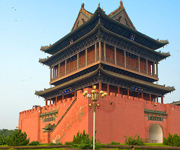
Linfen (simplified Chinese: 临汾; traditional Chinese: 臨汾; pinyin: Línfén) is a prefecture-level city in southern Shanxi province, People's Republic of China. It is situated along the banks of the Fen River. It has an area of 20,275 square kilometres (7,828 sq mi) and according to the 2010 Census, a population of 4,316,612 inhabitants of which 944,050 live in the built-up (or metro) area made up of Yaodu urban district. It was known as Pingyang (平阳) during the Spring and Autumn Period. In 2006, New York based Blacksmith Institute listed Linfen as one of the ten most polluted cities in the world. Prior to 1978, Linfen was famous for its spring water, greenery and rich agriculture and therefore nicknamed "The Modern Fruit and Flower Town". Since then it has been developing into a main industrial center for coal mining, which has been seriously damaging the city's environment, air quality, farming, health and its past status as a green village.

Taiyuan (Chinese: 太原; pinyin: Tàiyuán [tʰaɪ̂ɥɛ̌n], also known as Bing (并), Jinyang (晋阳)) is the capital and largest city of North China's Shanxi province.[2] At the 2010 census, it had a total population of 4,201,591 inhabitants on 6,959 km2 (2,687 sq mi), from whom 3,212,500 are urban on 1,460 km2 (560 sq mi). The name of the city literally means "Great Plains", referring to the location where the Fen River leaves the mountains. The city is located at the centre of the province with an East-West span of 144 km and a North-South span of 107 km.

Fuxin (Chinese: 阜新; pinyin: Fùxīn) is a prefecture-level city in northwestern Liaoning province, People's Republic of China. The total population of the prefecture at the 2010 census is 1,819,339, of whom 669,317 are resident in the built up area, which comprises four urban districts, collectively known as 'Fuxin City'. Fuxin has a monsoon-influenced humid continental climate (Köppen Dwa), with long, cold but dry winters and hot, humid summers. A majority of the annual precipitation falls in July and August alone.

Jinzhou (simplified Chinese: 锦州; traditional Chinese: 錦州; pinyin: Jǐnzhōu), is a prefecture-level city of Liaoning province, People's Republic of China. It is a geographically strategic city located in the "Liaoxi Corridor" (辽西走廊), which connects land transportation between North China and Northeast China. Jinzhou is China's northernmost seaport and the coastal economic center of West Liaoning on the north-western shore of the Bohai Sea. The total area under the jurisdiction of Jinzhou is 10,111 square kilometres (3,904 sq mi), most of which is rural, encompassing a coastline of 97.7 km (60.7 mi). It is one of the biggest cities in Liaoning with a population of 3,126,463 at the 2010 census, of whom 1,091,799 reside in the built-up area made of 3 urban districts.
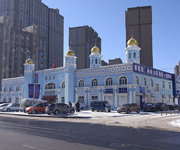
Jiamusi (Manchu: Giyamusi, Chinese: 佳木斯; pinyin: Jiāmùsī; formerly Kiamusze) is a prefecture-level city in eastern Heilongjiang province, People's Republic of China. Located along the middle and lower reaches of the Songhua River, it faces Russia's Khabarovsk Krai across the Ussuri River and the Amur River. In 2007 Jiamusi had a GDP of RMB 34.1 billion with a 14.3% growth rate. Its population was 2,552,097 at the 2010 census whom 881,711 lived in the built up area made of 4 urban districts.

Mudanjiang (Chinese: 牡丹江; pinyin: Mǔdānjiāng; Manchu: Mudan bira) is a prefecture-level city in southernmost Heilongjiang province, People's Republic of China. It was called Botankou when it was under Japanese occupation. It serves as a regional communications hub with a railway junction and an international airport connecting with several major Chinese cities as well as Seoul, Korea. Mudanjiang is also an important border city, located only 248 km (154 mi) from Vladivostok, Russia. In 2011 Mudanjiang had a GDP of RMB 93.48 billion with a 15.1% growth rate. Its population is 2,798,723 at the 2010 census whom 965,154 live in the built-up (or metro) area made of 4 urban districts. In 2007, the city is named China's top ten livable cities by Chinese Cities Brand Value Report, which was released at 2007 Beijing Summit of China Cities Forum.
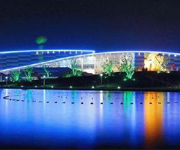
Bengbu (Chinese: 蚌埠; pinyin: Bèngbù; Wade–Giles: Peng-pu) is a mid-sized city in northern Anhui Province, China. Its built-up (or metro) area made of 4 urban districts has nearly one million residents, though the Prefecture-level city under its jurisdiction had 3,164,467 registered residents at the 2010 census. Its name means "Oyster Wharf" in Chinese, echoing its former reputation as a freshwater pearl fishery. The city's urban agglomeration is about to include Huaiyuan county, which is under its jurisdiction, as well as Fengyang county in Chuzhou municipality. This contiguous built-up area would have approximately 2.6 million residents.

Hefei, formerly known as Hofei, Luzhou, or Luchow, is the capital and largest city of Anhui Province in Eastern China. A prefecture-level city, it is the political, economic, and cultural centre of Anhui. Located in the central portion of the province, it borders Huainan to the north, Chuzhou to the northeast, Chaohu to the southeast and Lu'an to the west. Hefei has an area of 11,434.25 km2 (4,414.79 sq mi) and, at the 2013 census, a population of 7,611,000 inhabitants. Its built-up area ("metro") was home to 5,031,123 inhabitants at the 2010 census encompassing all urban districts and Feidong and Feixi counties largely being urbanized.
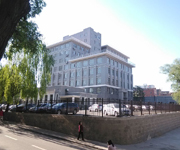
Binzhou (simplified Chinese: 滨州; traditional Chinese: 濱州; pinyin: Bīnzhōu; literally: "coastal prefecture") is a prefecture-level city in northern Shandong province, People's Republic of China. Sitting on the northern bank of the Yellow River with two arms extended to the southern bank, Binzhou borders the provincial capital of Jinan to the southwest, Dezhou to the west, Zibo to the south, Dongying to the east, and the province of Hebei to the north. The city also has a short coastline bordering the Bohai Bay. Humans have been living in the area around Binzhou since the Neolithic era. It was called “Pugu country” in the Shang Dynasty, and was a county in the Qin Dynasty. It was first called Binzhou in era of the Five Dynasties because it borders the Bohai Sea. Nowadays, it has more than 3.7 million inhabitants. The major Industries are based on oil, chemicals and textiles.

Qingdao (Chinese: 青岛; pinyin: About this sound Qīngdǎo (help·info); former German: Tsingtau; former official romanization: Tsingtao) is a major city in eastern Shandong Province, Eastern China. Administered at the sub-provincial level, Qingdao has jurisdiction over seven districts and five county-level cities. According to the 2010 census, the built-up (or metro) area made up of 6 urban districts and Jimo City had 5,764,384 inhabitants, while the total population of the sub-provincial city is up to 8.71 million. Lying across the Shandong Peninsula and looking out to the Yellow Sea, it borders Yantai to the northeast, Weifang to the west and Rizhao to the southwest. Qīng (青) in Chinese means "green" or "lush", while dǎo (岛) means "island". Qingdao is a major seaport, naval base, and industrial centre. The world's longest sea bridge, the Jiaozhou Bay Bridge, links the main urban area of Qingdao with Huangdao district, straddling the Jiaozhou Bay sea areas. It is also the site of the Tsingtao Brewery, the second largest brewery in China. In 2007, Qingdao was named as among China's top ten cities by the Chinese Cities Brand Value Report, which was released at the 2007 Beijing Summit of China Cities Forum. In 2009, Qingdao was named China's most livable city by the Chinese Institute of City Competitiveness.
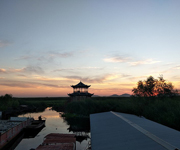
Tai'an (Chinese: 泰安; pinyin: Tài'ān) is a prefecture-level city in western Shandong province. Centered on Mount Tai, the city borders the provincial capital of Jinan to the north, Laiwu to the northeast, Zibo to the east, Linyi to the southeast, Liaocheng to the extreme west and Jining to the south. To the west, Tai'an is separated from the province of Henan by the Yellow River. Its population was 5,494,207 as of the 2010 census, of whom 1,735,425 lived in the built-up (or metro) area made of 2 urban districts (Taishan District and Daiyue District).

Yantai (Chinese: 烟台; pinyin: Yāntái), formerly known as Chefoo or Chih-fou, is a prefecture-level city in northeastern Shandong province, People's Republic of China. Located on the Bohai Strait and the southern coast of the Korea Bay, Yantai borders the cities of Qingdao and Weihai to the southwest and east respectively. It is the largest fishing seaport in Shandong. Its population was 6,968,202 at the 2010 census whom 2,227,733 lived in the built-up area made up of 4 urban districts (Zhifu, Muping, Fushan and Laishan). The contemporary name of Yantai came from the watchtowers constructed on Mount Qi in 1398, during the reign of the Hongwu Emperor, founding emperor of the Ming Dynasty (yan—smoke; tai—tower). The towers served to raise alarms against invasions of Japanese pirates.

Zibo (Chinese: 淄博; pinyin: Zībó) is a prefecture-level city in central Shandong province, People's Republic of China. It borders the provincial capital of Jinan to the west, Laiwu and Tai'an to the southwest, Linyi to the south, Weifang to the east, Dongying to the northeast, and Binzhou the north. Located in the centre of Shandong, Zibo is an important transportation hub. Zibo governs 5 districts (Zhangdian, Zichuan, Boshan, Zhoucun and Linzi) and each of these districts has a distinct downtown area of their own. The T-shaped city has a total area of 5,938 km2 (2,293 sq mi), including the counties of Huantai, Gaoqing, and Yiyuan. Zibo's total population was 4.53 million at the 2010 census, of which 3,633,239 inhabitants lived in the built-up area made of 5 urban districts (metro area) plus Huantai county largely being built. The built-up area is being conurbated with Zouping County in Binzhou municipality. Zibo was the centre of the ancient State of Qi, whose capital Linzi was the most populous city in the east about 3000 years ago. Zibo is the birthplace of ancient football Cuju, which according to FIFA, was the earliest form of the sport. Pu Songling, a well-known writer of the Qing Dynasty, is one of the most famous people from Zibo. As the birthplace of Qi Culture and because of the abundant natural resources, it is an excellent tourist city in China.
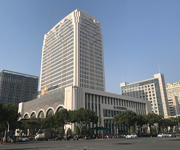
Jinhua (help·info), is a prefecture-level city in central Zhejiang province in eastern China. It borders the provincial capital of Hangzhou to the northwest, Quzhou to the southwest, Lishui to the south, Taizhou to the east, and Shaoxing to the northeast. Its population was 5,361,572 at the 2010 census including 1,077,245 in the built-up area made of two urban districts even though Lanxi City is also being conurbated soon. One can notice that the cities of Dongyang and Yiwu are now in the same agglomeration, a built-up area of 2,038,413 inhabitants bigger than the one of Jinhua itself. Jinhua is rich in red soil and forest resources. The Jinhua or Wu River flows through the Lan and Fuchun to the Qiantang River beside Hangzhou, which flows into Hangzhou Bay and the East China Sea. In mediaeval China, it formed part of the water network feeding supplies to the southern end of the Grand Canal. It is best known for its dry-cured Jinhua ham.
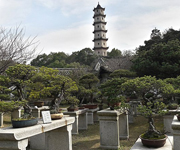
Wenzhou (About this sound listen (help·info)) (simplified Chinese: 温州市; traditional Chinese: 溫州市; pinyin: Wēnzhōu Shì; former official name: Wenchow) is a prefecture-level city in southeastern Zhejiang province in the People's Republic of China. At the time of the 2010 Chinese census, 6,642,592 people lived in its built-up (or metro) area made of Wenzhou's city proper (3,039,439 inhabitants in 3 urban districts), Ruian and Yueqing cities largely being urbanized, and Yongjia County conurbated on its southern part. The area under its jurisdiction (which includes two satellite cities and six counties) held a population of 9,122,102. Its coastline opens on the East China Sea; its borders connect it to Lishui on the west, Taizhou on the north, and Fujian to the south. The name Wenzhou, translates to "a mild and pleasant land." Originally known as Yongjia, Yung-chia or Yungkia (Chinese: 永嘉; pinyin: Yǒngjiā), Wenzhou was a prosperous foreign treaty port, which remains well-preserved today. It is situated in a mountainous region and, as a result, has been isolated for most of its history from the rest of the country, making the local culture and language very distinct not only from the rest of China but from neighbouring areas as well. It is also known for its emigrants who leave their native land for Europe and the United States, with a reputation for being entrepreneurs who start restaurants, retail and wholesale businesses in their adopted countries. People of Wenzhou origin make up a large number of ethnic Chinese residents of Italy, France, and Spain.
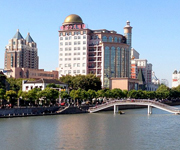
Nantong (Chinese: 南通; pinyin: Nántōng; former names: Nan-t'ung, Nantung, Tongzhou, or Tungchow; Qihai dialect: [nie tʰoŋ]) is a prefecture-level city in Jiangsu province, China. Located on the northern bank of the Yangtze River, near the river mouth. Nantong is a vital river port bordering Yancheng to the north, Taizhou to the west, Suzhou and Shanghai to the south across the river, and the East China Sea to the east. Its current population is 7,282,835 at the 2010 census, 1,994,708 of whom live in the built-up area made up of 3 urban districts.

Wuxi (simplified Chinese: 无锡; traditional Chinese: 無錫; pinyin: Wúxī) is an old city in southern Jiangsu province, People's Republic of China. Split in half by Lake Tai, Wuxi borders Changzhou to the west and Suzhou to the east. The Yangtze River lies between the northern half of Wuxi and Taizhou, while the southern half of the city borders the province of Zhejiang. Wuxi is also famous for being one of the birthplaces of China's modern industry and commerce, as well as the hometown of many important businessmen who have played essential roles in building commerce in Shanghai since the early 20th century.

Xuzhou, otherwise known as Pengcheng in ancient times, is a major city in and the fourth largest prefecture-level city of Jiangsu province, People's Republic of China. Its population was 8,577,225 at the 2010 census whom 2,623,066 lived in the built-up (or metro) area made of Quanshan, Gulou, Yunlong and Tongshan districts. It is known for its role as a transportation hub in northwestern Jiangsu, as it has expressways and railway links connecting directly to the provinces of Henan and Shandong, the neighboring port city of Lianyungang, as well as the economic hub Shanghai. Before the adoption of Hanyu Pinyin, the city's name was typically Romanized as Suchow, Süchow, although also appearing as Siu Tcheou [Fou], Hsu-chou, Hsuchow, and Hsüchow.
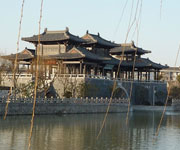
Yangzhou (simplified Chinese: 扬州; traditional Chinese: 揚州; pinyin: Yángzhōu) is a prefecture-level city in central Jiangsu province in the People's Republic of China. Sitting on the northern bank of the Yangtze River, it borders the provincial capital of Nanjing to the southwest, Huai'an to the north, Yancheng to the northeast, Taizhou to the east, and Zhenjiang across the river to the south. Its population is 4,414,681 at the 2010 census and its built up area is home to 2,146,980 inhabitants including three urban districts plus currently in the agglomeration. Historically it is one of the wealthiest of China's cities, known at various periods for its great merchant families, poets, painters, and scholars. Its name (lit. "Rising Prefecture") refers to its former position as the capital of Yangzhou prefecture in imperial China.
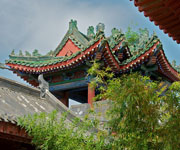
Kaifeng (simplified Chinese: 开封; traditional Chinese: 開封; pinyin: Kāifēng; Wade–Giles: K'aifeng), known previously by several names (see below), is a prefecture-level city in east-central Henan province, People's Republic of China. It was once the capital of the Northern Song Dynasty. There are currently nearly 5 million people living in its metropolitan area. Located along the southern bank of the Yellow River, it borders the provincial capital of Zhengzhou to the west, Xinxiang to the northwest, Shangqiu to the east, Zhoukou to the southeast, Xuchang to the southwest, and the province of Shandong to the northeast.
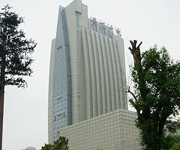
Huangshi (simplified Chinese: 黄石; traditional Chinese: 黃石; pinyin: Huángshí; literally: "yellow rock") is a prefecture-level city in southeastern Hubei province, People's Republic of China. Its population was 2,429,318 inhabitants at the 2010 census whom 1,601,687 in the built-up (or metro) area made of 4 urban district plus the city of Daye now being part of the agglomeration.
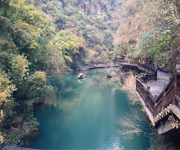
Yichang (Chinese: 宜昌) is a prefecture-level city located in western Hubei province, People's Republic of China. It is the second largest city in the province after the capital, Wuhan. The Three Gorges Dam is located within its administrative area, in Yiling District. At the 2010 census, its population was 4,059,686 inhabitants whom 1,350,150 lived in the built-up (or metro) area made of Yiling, Xiling, Wujiagang and Dianjun urban districts as Xiating District is not conurbated yet.
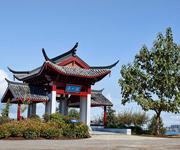
Fuzhou (Chinese: 福州; pinyin: Fúzhōu, [fǔtʂóʊ]; Fuzhou dialect: Hók-ciŭ; also formerly Minhow) is the capital and one of the largest cities in Fujian province, People's Republic of China. Along with the many counties of Ningde, those of Fuzhou are considered to constitute the Mindong (lit. East of Fujian) linguistic and cultural area. Fuzhou's core counties lie on the north (left) bank of the estuary of Fujian's largest river, the Min River. All along its northern border lies Ningde, and Ningde's Gutian County lies upriver. Fuzhou's counties south of the Min border on Putian, Quanzhou, Sanming and Nanping prefectures. Its population was 7,115,370 inhabitants as of the 2010 census, of whom 4,408,076 inhabitants are urban standing around 61.95%, while rural population is at 2,707,294 standing around 38.05 percent.
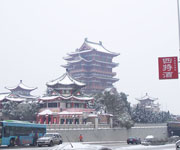
Nanchang (Chinese: 南昌; pinyin: Nánchāng) is the capital of Jiangxi Province in southeastern China, located in the north-central portion of the province. It is bounded on the west by the Jiuling Mountains, and on the east by Poyang Lake. Because of its central location relative to the Yangtze and Pearl River Delta regions, it is a major railroad hub in Southern China. Its population was 5,042,566 whom 4,171,926 in the built-up area made up of six urban districts plus the urbanized counties of Nanchang and Xinjian. As the Bayi Riot 1927 was distinctively recognized by the ruling Communist Party as "firing the first gunshot against the evil Republic of China", the current communist regime has therefore named the city since 1949 "the City of Heroes", "the place where the People's Liberation Army was born", and the most widely known "place where the military banner of the People's Liberation Army was first raised".
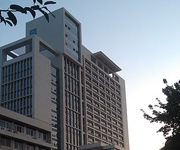
Shàntóu (Chinese: 汕头), also known as Swatow or Suátao, is a prefecture-level city on the eastern coast of Guangdong province, People's Republic of China, with a total population of 5,391,028 as of 2010 and an administrative area of 2,064 square kilometres (797 sq mi). Shantou has direct jurisdiction over six districts and one county, and the six urban districts of Shantou has a population of 5,330,764. With it and the surrounding cities of Jieyang and Chaozhou, the metropolitan region known as Chaoshan covers an area of 10,404 km2 (4,017 sq mi), and had a permanent population of 13,937,897 at the end of 2010. It's built up area spread of 11 districts was home to 11,635,577 inhabitants at the 2010 census. Shantou, a city significant in 19th-century Chinese history as one of the treaty ports established for Western trade and contact, was one of the original Special Economic Zones of the People's Republic of China established in the 1980s, but did not blossom in the manner that cities such as Shenzhen, Xiamen and Zhuhai did. However, it remains eastern Guangdong's economic centre, and is home to Shantou University, a member of the Project 211 group.

Guìyáng (Chinese: 贵阳) is the capital of Guizhou province of Southwest China. It is located in the centre of the province, situated on the east of the Yunnan–Guizhou Plateau, and on the north bank of the Nanming River, a branch of the Wu River. The city has an elevation of about 1,100 meters. It has an area of 8,034 square kilometres (3,102 sq mi). Its population is 4,324,561 at the 2010 census whom 3,037,159 live in the built up area made of 7 urban districts.

Leshan (simplified Chinese: 乐山; traditional Chinese: 樂山; pinyin: Lèshān; literally: "Happy mountain"; Sichuanese Pinyin: No2san1; local pronunciation: [nʊʔ˧sã˥]) is a prefecture-level city located at the confluence of the Dadu and Min rivers in Sichuan Province, People's Republic of China. Leshan is located on the southwestern fringe of the Red Basin in southern Sichuan, about 120 km (75 mi) from Chengdu. At the 2010 census, its population was 3,235,759 whom 662,814 lived in the built-up (or metro) area made of Shizhong district, as Wutongqiao and Jinkouhe districts are not conurbated yet.
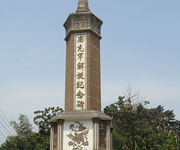
Nanchong (Chinese: 南充; pinyin: Nánchōng; Wade–Giles: Nan-ch'ung; Sichuanese: lan2cong1; ) is a prefecture-level city in the northeast of Sichuan province, People's Republic of China, with an area of 12,479.96 square kilometres (4,818.54 sq mi), and at the 2010 census was home to 6,278,614 people whom 1,858,875 lived in the built-up (or metro) area made of 3 urban districts. It is the second most populated city of Sichuan Province, only after Chengdu. The administrative center is Shunqing District.
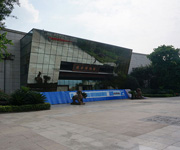
Ya'an (Chinese: 雅安; pinyin: Yǎ'ān; Wade–Giles: Ya-an, Tibetan: Yak-Nga [གཡག་རྔ་]) is a prefecture-level city in the western part of Sichuan province, People's Republic of China, located just below the Tibetan Plateau.

Luzhou (simplified Chinese: 泸州; traditional Chinese: 瀘州; pinyin: Lúzhōu; Sichuanese Pinyin: Nu2zou1; Luzhou dialect: [nu˨˩tsəu˥]), formerly transliterated as Lu-chou or Luchow, is a prefecture-level city located in the southeast of Sichuan Province, People's Republic of China. The city, named Jiangyang until the Southern and Northern Dynasties, is known as the "wine city". Situated at the confluence of the Tuo River and the Yangtze River, Luzhou is not only an important port on the Yangtze river, but also the largest port in both size and output in Sichuan province since Chongqing seceded from Sichuan province in 1997. At the 2010 census its population was 4,218,427 inhabitants whom 919,832 lived in the built-up (or metro) area made of Jiangyang and Longmatan districts, as Naxi district isn't conurbated yet. Luzhou, which borders Yunnan, Guizhou and Chongqing, is the only geographic junction of the four provinces, and was therefore the logical place for a port in ancient China. After the PRC was founded in 1949, Luzhou became the capital of southern Sichuan province. In 1983, Luzhou was approved as a prefecture-level city administratively.
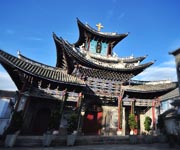
Dali City (Chinese: 大理市; pinyin: Dàlǐ shì; Bai: Darl•lit; Hani: Dafli) is a county-level city in and the seat of the Dali Bai Autonomous Prefecture, in northwestern Yunnan province, People's Republic of China. Dali is one of the most popular tourist destinations in Yunnan, known for its natural scenery and historical and cultural heritage.
Mengzi (Chinese: 蒙自; pinyin: Měngzì; former French romanization: Mongtseu; Chinese Postal Map Romanisation spelling: Mengtsz) is a city in the southeast of Yunnan province, People's Republic of China. Administratively, it is a county-level city and the seat of the Honghe Hani and Yi Autonomous Prefecture, located about 175 kilometres (109 mi) south-southeast of the provincial capital of Kunming. It is situated in the centre of a fertile valley basin on a plateau 1,000 metres (3,300 ft) above sea level. Mengzi was formerly Mengzi County (蒙自县) until October 2010, when it was upgraded to a county-level city.
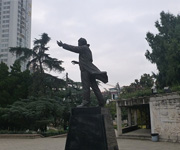
Yuxi (Chinese: 玉溪; pinyin: Yùxī) is a prefecture-level city in the Yunnan province of the People's Republic of China. The administrative center of Yuxi is Hongta District. Yuxi is approximately 90 kilometres (56 mi) south of Kunming.
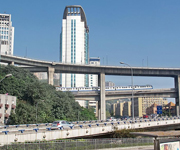
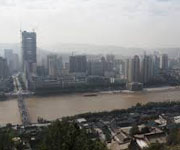
Lánzhōu (simplified Chinese: 兰州; traditional Chinese: 蘭州; Postal map spelling: Lanchow) is the capital and largest city of Gansu Province in Northwest China. A prefecture-level city, it is a key regional transportation hub, allowing areas further west to maintain railroad connections to the eastern half of the country. Lanzhou is home to 3,616,163 inhabitants at the 2010 census and 2,177,130 in the built-up area (urban) of 1,088 square kilometres (420 sq mi).

Yinchuan is the capital of the Ningxia Hui Autonomous Region, People's Republic of China, and former capital of the Western Xia Empire of the Tanguts. It has an area of 4,467 km (2,776 mi) and a total population of 1.99 million. Its built up area is home to 1,290,170 inhabitants spread on 3 urban districts. The name of the city literally means "silver river"; the character for "river" (Chinese: 川; pinyin: chuān) is the same as that in Sichuan, but not as those in, for example, the Yellow River (simplified Chinese: 黄河; traditional Chinese: 黃河; pinyin: Huánghé) or Yangtze River (simplified Chinese: 长江; traditional Chinese: 長江; pinyin: Chángjiāng).

Yangling District (simplified Chinese: 杨陵区; traditional Chinese: 楊陵區; pinyin: Yánglíng Qū) is a district of the city of Xianyang, Shaanxi province, People's Republic of China, located on the plains of the Wei River. It has an area of 94 square kilometres (36 sq mi) and a population of 155,000. The district is roughly 80 kilometres (50 mi) to the west of the provincial capital Xi'an.
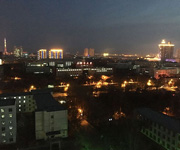
Shihezi (Chinese: 石河子; pinyin: Shíhézǐ; literally: "Stony river banks"; Uyghur: شىخەنزە, ULY: Shixenze, UYY: Xihənzə?) is a sub-prefecture-level city in northern Xinjiang, People's Republic of China. Shihezi is located at the northern foothills of the middle part of the Tian Shan range approximately 136 kilometres (85 mi) from the regional capital of Ürümqi.
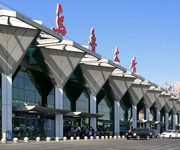
Ürümqi (/uːˈruːmtʃi/, literally "beautiful pasture", from Mongolian), is the capital of Xinjiang Uyghur Autonomous Region of the People's Republic of China in the northwest of the country. Urumqi was a major hub on the Silk Road during China's Tang dynasty, and developed its reputation as a leading cultural and commercial center during the Qing dynasty. With a built-up (or metro) population of 2,988,715 as of 2010 census (6 urban and suburban districts but Dabancheng not yet urbanized) and 3.03 million in 7 urban and suburban districts, Ürümqi is the largest city in China's western interior. Since the 1990s Ürümqi has developed economically and now serves as a regional transport node, cultural, and commercial centre.
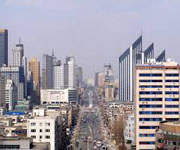
Anshan (Chinese: 鞍山; pinyin: Ānshān; literally: "saddle mountain") is the third largest prefecture level city in Liaoning province, People's Republic of China. Situated in the central area of the province, Anshan is about 92 kilometres (57 mi) south of Shenyang, the provincial capital. Anshan is on the boundary between the Mountains of eastern Liaoning and the plains of the west. The prefecture has a population of 3,584,000 people and covers an area of about 9,252 km2 (3,572 sq mi). The distance from the east to the west of the prefecture is 133 km (83 mi). The area contains the famous Qianshan National Park. The city's name is derived from the shape of a nearby mountain that resembles the shape of a horse's saddle, which can be seen on the left (west) about five minutes before the northbound train arrives at Anshan Station. Anshan is home to the Anshan Iron and Steel Group, one of the largest steel producers in China. Anshan is sister cities with Sheffield Anshan has a population of 3.65 million at the 2010 census. Anshan holds one third of the worlds supply of talcum. Anshan holds a quarter of the worlds reserves of magnesite. Anshan also produced the largest ever jade stone, now a local tourist attraction carved as a Buddha. The built up area encompassing 4 Anshan urban districts (1,529,350 inhabitants) and urban Liaoyang is home to more than 2.17 million inhabitants in 2010.
Yiwu (simplified Chinese: 义乌; traditional Chinese: 義烏; pinyin: Yìwū) is a city of about 1.2 million people[3] in central Zhejiang province, People's Republic of China. Its built-up (or metro) area made of Yiwu and Dongyang cities was home to 2,038,413 inhabitants at the 2010 census. The city is famous for its small commodity trade and vibrant market and is a regional tourist destination. Although administratively Yiwu is a county-level city under the jurisdiction of Jinhua, it is more well-known than Jinhua nationally and internationally.
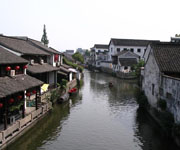
Shaoxing (help·info) is a prefecture-level city on the southern shore of Hangzhou Bay in northeastern Zhejiang province, China. It was formerly known as Kuaiji and Shanyin and abbreviated in Chinese as 越 (Yuè) from the area's former inhabitants. Located on the south bank of the Qiantang River estuary, it borders Ningbo to the east, Taizhou to the southeast, Jinhua to the southwest, and Hangzhou to the west. The city itself is lined with numerous canals and waterways, giving it a classic Jiangnan style scenery though more mountainous than is typical for Jiangnan. At the 2010 census, its population was 4,912,339 inhabitants whom 1,914,683 (Keqiao and Yuecheng districts) lived in the built-up area of Hangzhou-Shaoxing, with 8,156,154 inhabitants. Shaoxing has long been a hotbed of Chinese cultural activity, producing such luminary figures as Wang Xizhi, Zhou Enlai, Lu Xun, and Cai Yuanpei. It is widely known throughout China for Shaoxing wine, meigan cai, and stinky tofu, and was recently featured on A Bite of China. Its local variety of Chinese opera sung in the local dialect and known as Yue or Shaoxing opera is second in popularity only to Peking opera. In 2010, Shaoxing celebrated the 2500th anniversary of the founding of the city. Economically, the city's driven by manufacturing of textiles, electronics, and energy efficient lighting. Zhejiang has the fifth highest per capita GDP in the nation, with the city itself at 32nd nationally by GDP per capita.
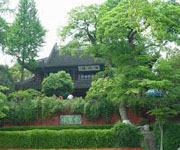
Jiaxing (Chinese: 嘉兴; pinyin: Jiāxīng; Wu Chinese: Gāshīng [kɑɕiŋ]) is a prefecture-level city in northern Zhejiang province, People's Republic of China. Lying on the Grand Canal of China, Jiaxing borders Hangzhou to the southwest, Huzhou to the west, Shanghai to the northeast, and the province of Jiangsu to the north. At the 2010 census, its population was 4,501,657 and its built-up area made of 2 urban districts was home to 1,201,882 inhabitants.

Wuhu (simplified Chinese: 芜湖; traditional Chinese: 蕪湖; pinyin: Wúhú; literally "Weedy Lake") is a prefecture-level city in southeastern Anhui province, People's Republic of China. Sitting on the southeast bank of the Yangtze River, Wuhu borders Xuancheng to the southeast, Chizhou and Tongling to the southwest, Hefei to the northwest, Ma'anshan to the northeast, and the province of Jiangsu to the east, and is approximately 90 km (56 mi) southwest of Nanjing. Its population was 3,545,067 inhabitants at the 2010 census whom 1,264,539 in the built-up (or metro) area made of 3 out of 4 urban districts (all but Sanshan not yet continuously urbanized).
 Immediate attention
Immediate attention